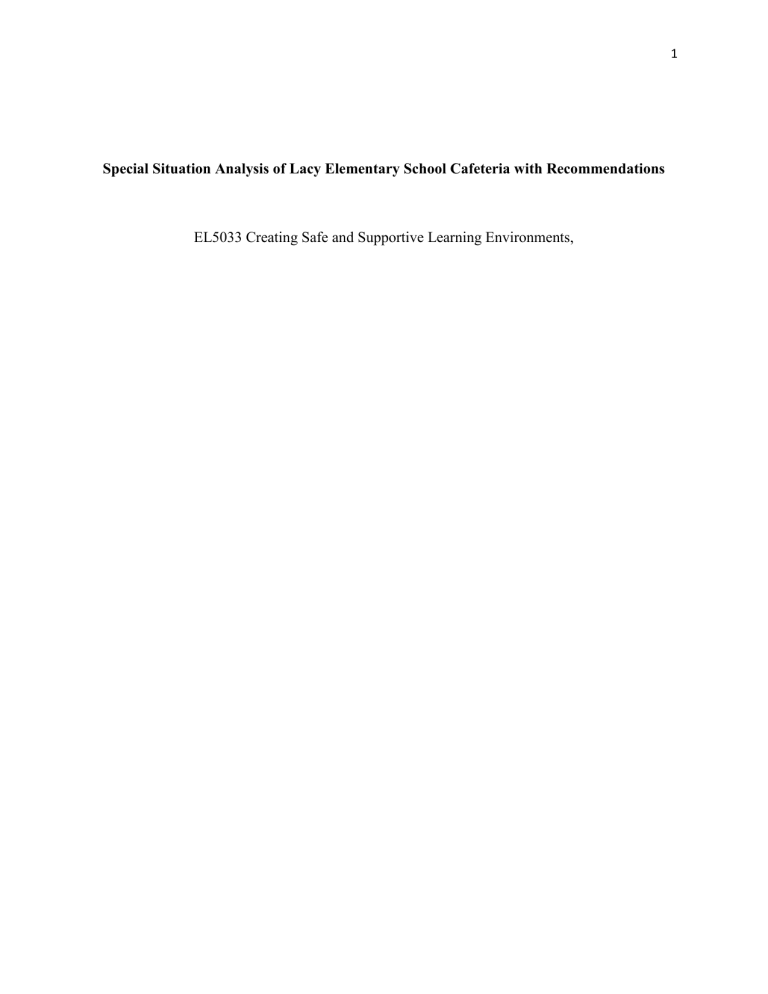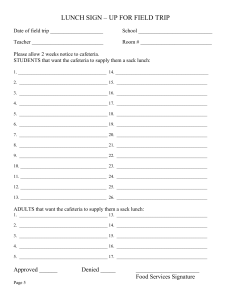Special Situation Analysis of Lacy Elementary School Cafeteria With Recommendations Sample
advertisement

1 Special Situation Analysis of Lacy Elementary School Cafeteria with Recommendations EL5033 Creating Safe and Supportive Learning Environments, 2 Special Situation Analysis of Lacy Elementary School Cafeteria with Recommendations Students are guaranteed to get into some mischief if they are not observed constantly. This is especially true in common areas. According to Wheatley et al. (2019), the common areas are the hallways, cafeteria, bathroom, playgrounds, bus lines, and bus. Lacy Elementary School's Café observation revealed some areas are going well, especially during breakfast. However, there seems to be a problem with lunch and changes need to be made for the safety of the students and the school. These common areas, such as café, lack established routines and clear behavioral expectations resulting in high rates of problematic behavior (Oswald et al., 2005, p.265) This is because of the lack of direct supervision and the large number of students per adult. Lacy Elementary café has been observed three times using five analyses. The five analyses are Student characteristics, issues and factors; Teacher/staff characteristics, issues and factors; Incentives and consequences; Environmental characteristics issues and factors: Physical plant and logistics and Resources. Student Characteristics, Issues and Factors Lacy Elementary school is a 60-year-old school built to accommodate 500 students but is currently serving 650 students. The school is apparently a Title 1 school since most students qualify for free or reduced lunch. Two hundred students ride the bus due to rezoning. Breakfast starts one hour before school begins, and teachers must be clocked in 15 minutes before school starts. There is one school administrator and two paraprofessionals supervising breakfast. Observation one during breakfast shows the students are demonstrating good behavior and know what is expected of them. Within the cafeteria, there are two paraprofessionals, one administrator. Students are observed talking quietly with their peers and completing their 3 homework. Once it's time to go to class, most students take their trash and put it in the garbage, and there are rare disruptions in traffic flow. However, this cannot be said for lunchtime. Observations two and three occurred during lunchtime. The students are subjected to a long lunch line which takes approximately 20 minutes to get their lunch. Students are observed scrambling to find a seat. Some of them are moving about in the lunchroom from table to table. Students are shoving and pushing each other because of the crowded situation and using one door. There are two lunch periods, and each period is 45 minutes. The lunch period is supervised by three paraprofessionals, three parents, and two administrators. However, there is still a lot of discipline issues during lunch. During lunchtime, students are very loud, and some must use the restroom. Some students are observed leaving the lunchroom without leaving their ID because they do not have one. Faculty and staff are not enforcing the behavioral matrix to be responsible, use their inside voices, and be safe by staying at their table in their seat. However, some of the students are doing homework and exhibiting positive behavior. When lunch is over, students rush to line up at the door before the bell rings; some tables are left with trays and trash still on the table. When students are released from the cafeteria, they all exit through one door, which causes a lot of pushing and shoving. Some students exhibit disrespect towards faculty members when asked to stop running down the hall. Teacher/Staff Characteristics, Issues, and Factors Breakfast time seems to run smoothly with the two paraprofessionals and one administrator. However, lunchtime needs to be revamped. Teachers walk their students to the cafeteria for lunch; however, they leave because of their duty-free lunch period. There are eight adults in the cafeteria at lunchtime, and some students are exhibiting inappropriate behavior in the cafeteria. A parent or staff member nearby breaks up a skirmish, pushing and shoving, which 4 could have happened because of the long wait in line. A cafeteria worker releases students all at one time to go to class or recess, and this is a safety issue. Perhaps the teachers need to spread around in the cafeteria to cover all areas and enforce the school's behavioral matrix. Faculty members and staff are not consistent in following the behavioral matrix and allowing some students to leave the café without their student ID and others not. Students are willfully disobeying the faculty without and consequences. Environmental Characteristics, Issues, and Factors There are 300-fold-up tables for 325 students per lunch period; therefore, cafeteria workers must bring in additional chairs to the cafeteria. This causes the students to rush to get the best seating. Because there are only two lunches, the lines and the wait are long. The long wait and lines can cause the students to misbehave or become agitated, which is why some may push and shove. A safety issue is that 325 students must exit through one door. Incentives and Consequences The first thing noticed is that there are no consequences for the students shouting, pushing, and shoving. Although the parent or staff member broke it up, no consequences were given. Also noted is the students move around the cafeteria without consequences. Students continued to run down the hall, and no consequences were given. A few students are working on their homework. However, they are not given an incentive for displaying the expected behavior. Resources Although students use the restroom during lunchtime, there are only one adult checking IDs for restroom usage. For a large number of students present for each lunch period, there are only eight adults. That is approximately 41 students per adult, which is a large number for the special setting. 5 Action Plan and Recommendations Based on the observation of Lucy Elementary, teachers need to be consistent in following the school's behavioral matrix. If students do not see consistency, they will not follow the matrix and will display hostile behavior. An intervention team shall be created. The team consisting of school faculty, staff, community, and parent volunteers will focus on the layout of the cafeteria, seating, exit procedures, and improving the café experience. Research has shown that interventions can achieve multiple positive outcomes for students, reducing negative behavior (Rafa., 2019). The current PBIS behavioral matrix will need to be re-evaluated and enforced across all areas of the school's including common areas. At the beginning of school, teachers should be reminded about being consistent when following the behavior matrix. Faculty and staff will model and demonstrate active supervision in common areas, which has been shown to decrease problem behaviors in the common areas (Wheatly et al., 2009, p.555). Teachers should also walk their students to lunch and, for the first week, sit with them to enforce what is expected behavior for the cafeteria. Students will sit at assigned tables when they enter the cafeteria. Tables will be called to line students up to get their lunch, and they must immediately return to their table once they have obtained their lunch. Once it's time to leave the cafeteria, students will only begin cleaning when a supervising adult calls on their table. They will stand up, empty their tray, put it on the cart, clean up any trash on the floor or table of their seating area and sit back down and wait for their teacher. It is also recommended that staggering lunches can help with the overcrowding and movement within the cafeteria. Currently, there are two 45-minute lunches, starting at 11:15 and ending at noon. Also, from noon to 12:45. Lunch A and Lunch B. You can add a Lunch C starting at 11:30 and ending at 12:15. The lunches will reduce the number of 6 students in the cafeteria line at once. Also, having three lunches will ease the crowdedness when the students are released to recess or back to class. Another advantage of adding a third lunch is the number of students to lunchroom adult supervisors will be sufficient. The adults should be stationed at a specific location to monitor the student's actions. However, if one faculty member must tend to an urgent matter, the adult closest to him should take the station. Have a plan written out in advance of who will cover what areas of the cafeteria and who will take over if someone must leave their duty station for an urgent matter. Environmental issues can be cleared up by having a third lunch. Three hundred twenty-five students will not try to rush out of the cafeteria at once. The exit process will flow smoothly by dismissing students from their table when their teacher shows up to pick them up. This will eliminate all students trying to exit at once. The teacher will supervise their students in the hallway to control the running and enforce walking inside a building. Students exhibiting the expected behavior during lunchtime should be rewarded with an incentive. This will encourage the other students to follow the behavioral matrix and display the expected behavior. Students not exhibiting the expected behavior should receive consequences. According to Knoff (2020) provides stronger incentives or consequences. If the students are making a mess, re-educate them on how to clean a table and have them clean the table for several days. For instance, students yelling across tables should receive a warning if the yelling doesn't stop; that student or table should receive silent lunch. This will enforce being respectful and using your inside voice. All teachers must be consistent in consequences for not following the matrix's expected behavior and providing incentives for expected behavior. Therefore, in conclusion, students will get into mischief if they are not closely supervised. Lacy Elementary School needs to implement an action team to focus on the logistics 7 and layout. The team should also redo the behavioral matrix and re-educate the faculty and staff to be consistent with the plan. Lunchtime should run smoother by having three lunches instead of two. Teachers will need to supervise their students for the first week of school in the cafeteria and pick them up from lunch. Consistently following the behavioral matrix and holding students accountable for their actions with consequences or rewards is essential. 8 References Knoff, H. (2020) Creating safe and supportive learning environments, Special Situations Interventions [Module 4 video], Ace productions. https://ace.instructure.com/courses/1842507/external_tools/118428 Oswald, K., Safran, S., & Johanson, G. (2005). Preventing Trouble: Making Schools Safer Places Using Positive Behavior Supports. EDUCATION AND TREATMENT OF CHILDREN, 3, 265. Rafa, A., & Education Commission of the States. (2019). Policy Analysis: The Status of School Discipline in State Policy. In Education Commission of the States. Education Commission of the States. Wheatley, R. K., West, R. P., Charlton, C. T., Sanders, R. B., Smith, T. G., & Taylor, M. J. (2009). Improving Behavior through Differential Reinforcement: A Praise Note System for Elementary School Students. Education & Treatment of Children (West Virginia University Press), 32(4), 551–571. https://doi.org/10.1353/etc.0.0071
